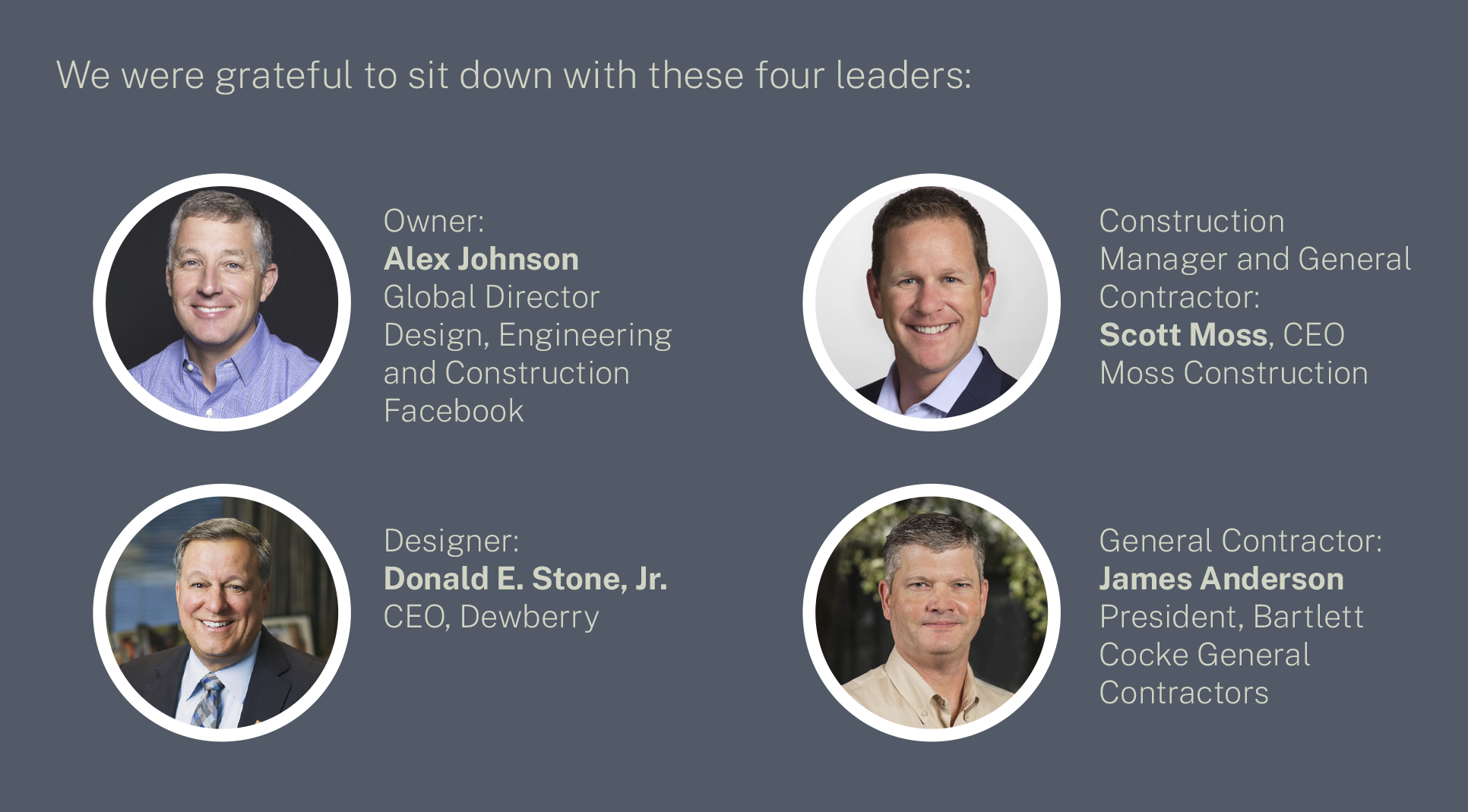Leading Construction Innovation and Agility in 2021

The more things change, the more the fundamentals remain the same.
As design and construction executives navigate through 2021, many are reaching the same conclusion: The more things change, the more the fundamentals remain the same. Signals remain mixed on what we are facing economically, socially and politically; and leaders are challenged to sort out the implications for our industry and the people around us. Most want information and are searching for insights, while continuing to rely on fellow industry leaders, perhaps more than ever, to figure out how to adapt to the post-2020 operating environment.
Expert advice in uncertain times
During times of disruption and volatility, FMI’s Leadership & Organizational Development practice advises executives on a variety of topics, including how best to adapt and build resilience in a post-pandemic world, when market conditions remain in flux.
We typically start the process by asking these questions:
- What have we learned about working safely in times of pandemic uncertainty that we should carry forward?
- How do we maintain the foundations of high engagement regardless of where people work or the uncertainty that generates bigger questions?
- What have we learned about how our leaders responded to ambiguity and uncertainty?
- Have we built sufficient organizational agility to find and do work regardless of external circumstances?
- What has changed in our markets that requires a shift in strategy? Is this the right time to rethink where to play and how to win?

This time we noticed a new set of questions on the minds of industry executives leading top-performing organizations. They were:
- How are other leaders balancing the tension between innovating for the future while improving performance efficiencies for the present?
- What are executives doing to create greater agility by going deeper with empowerment and trust?
- How can we increase a sense of safety and encourage employees to take risks, try new approaches and innovate at work?
It’s clear that many engineering and construction companies are balancing this tension with mixed results. Some invested heavily in innovation while others focused on operational efficiencies and profitability. So how are some leaders doing both well?
Rather than give FMI’s perspective on balancing this tension, we met with four industry executives to get their thoughts on those three questions. To get a well-rounded perspective, we included the owner’s, designer’s and contractor’s view.
There are no quick answers to any of these questions. However, the insights are best summarized by this quote from “One Mission” author and former U.S. Navy SEAL Chris Fussell:
Building an agile business, fueled by an empowered culture, is hard work. Each of these four organizations has built foundations for agility over time, not overnight. In addition to using the U.S. Navy SEAL mindset, these leaders took the time to slow down and think critically about their businesses, their people and their futures. They continue to trust their pre-2020 investments and strategies, and they all empower their employees. We hope their perspectives help readers see firsthand how different approaches lead to positive results.
Question 1: How are other leaders balancing the tension between innovating for the future while improving performance efficiencies for the present?
One approach certainly does not fit all, but several common themes emerged from our interviews. Innovation is a daunting word and often associated with mass change, disruptive technology or the start of something new. This group of leaders chose to view it differently.
An owner like Facebook operates in a hyper-innovative context every day. For Alex Johnson, global director for Design, Engineering and Construction (DEC) at Facebook, innovation for his group looks different today than it did when it was formed. Johnson explained the evolution when he noted, “We have to innovate, or the business will run over us. Everyone is empowered to give ideas here. Early on when we had a smaller team and a few sites, this innovation helped us optimize for the business needs but as we grew to over 2,500 people and significantly more sites and buildings on our data center team, we were consistently getting many more ideas than we could handle on a regular basis. We realized that a bunch of smaller incremental innovation ideas were weighing the program down, not driving it forward. Step function innovation became our primary driver because incrementalism is too cumbersome an approach with the number of massive projects we are pursuing. To make this work, we had to empower our high-performing teams to identify where and what must evolve. There is no right or wrong answer in this world. We’re all making our best guess for what is best and planning accordingly.”
We found it interesting that Johnson’s team tries to look 10 years out when planning and designing for its data center needs. Some of the technology it is planning for hasn’t even been designed, yet its leaders recognize that if they don’t think creatively, they will be overrun. Step function innovation is the team’s current solution to thinking strategically, innovatively and reasonably in a fast-paced environment.
Not surprisingly, construction managers and general contractors think differently about innovation than large technology companies do. Both construction leaders advised others to trust their investments. Both leaders made intentional strategic investments before 2020 and had to trust their decisions during turmoil.
James Anderson, president at Bartlett Cocke General Contractors, explained its long-standing company philosophy on innovation. “Any innovation we pursue has to support what we do. The tension goes beyond 2020 and has been guiding us for years. We decided to invest in innovation and made several key hires to push our thinking and systems. We leave it to their team to debate where we need to innovate, while the construction leaders debate the benefits outside the primary beneficiary. It’s a good tension for our leaders to debate and define what is really going to work.” By empowering leaders to discuss and vet ideas directly with one another, the innovation team gets firsthand feedback and time to refine plans.
Moss Construction CEO Scott Moss has an equally unique perspective on innovation. “We do not operate on the bleeding edge with innovation and 2020 didn’t change that. We will not chase the next app or technology buzz. At the same time one of our core values is ‘Empower to Create the Exceptional.’ When it comes to figuring out the balance, we leave it to our team leaders and their teams to decide what’s required to create exceptional – starting with people and team engagement.”
Balancing the tension between innovation and efficiency starts with a company’s vision, what it stands for, and its direction. This foundational work creates focus and stability for organizations in good times and even more so in ambiguous situations. Nearly all leaders noted that vision guided priorities and action in 2020, and that it continues to do so in 2021.
"Balancing the tension between innovation and efficiency starts with a company’s vision, what it stands for, and its direction. This foundational work creates focus and stability for organizations in good times and even more so in ambiguous situations. Nearly all leaders noted that vision guided priorities and action in 2020, and that it continues to do so in 2021."
Donald E. Stone, Jr., CEO at planning, design and construction firm Dewberry, explained how its core focus on the customer guided the company’s activities in 2020. “Our success began by seeking to understand client needs. High customer touch and understanding have always been at the core of how we do business. When the pandemic hit, we had to quickly figure out how to maintain this virtually. On day one, we quickly rallied around our clients to understand what they were experiencing. Our responsiveness to their needs increased client confidence, and we ultimately grew our business in 2020. We have not been hung up on the innovation craze the past few years and certainly didn’t jump on it last year. Innovation came in the way of how we used virtual platforms and other means to quickly understand and respond to client needs and concerns. In many cases we drew closer with key clients in spite of circumstances.” Dewberry’s core values and focus on true customer service helped guide leaders and team members to make decisions that were in the best interest of the client, and it continues to pay off. Stone and his team refined the direction as needed but allowed the previously established vision to guide the business throughout 2020.
Question 2: What are executives doing to create or deepen an environment of empowerment and trust?
Similar to innovation, empowerment and trust are daunting concepts for leaders to implement. Companies achieve empowerment and trust as a result of a leadership team’s approach not because of its strategy. Organizations that learned how to truly empower others and trust their people have intentionally built these mindsets and cultures over time, not overnight.
Going back to our U.S. military reference, Fussell served as assistant to then-Lt. Gen. Stanley McChrystal. The two leaders are known for their “Team of Teams” method of leading decentralized and empowered decision-making in the highest-stakes environments. This quote from McCrystal paraphrases much of what we heard from industry leaders on creating an environment steeped in trust and where people are empowered to do what’s necessary to win:
It was obvious that all four leaders we interviewed firmly believe in decentralizing control and creating their own empowered teams. By pushing decision-making down as far as possible, those leaders closest to the action can determine the need for a specific situation. Stories of accelerated performance, deeper confidence in leaders and trust among peers were common among the four companies we interviewed.
Stone explained that at Dewberry, “Our culture is built on decentralization and the freedom to think for yourself. Control is an illusion. We have a belief that for every new rule or policy put in place, we have to get rid of two. Those empowered are accountable to make things happen, while operating within the overarching parameters of our company’s strategic plan, strong ethical backbone and decision-making principles. Leaders hold each other accountable to a high standard of behavior. It has built immense trust and established a two-way agreement to honor our norms.”
General contractor Bartlett Cocke empowers employees on their first day with the company. Anderson explained the founder of the company, Bartlett Cocke Jr., told every employee to ask questions, speak up when they saw something that didn’t look right and to consider themselves owners on projects. He firmly believed in letting people make decisions and taking ownership to set their own direction every day. The company’s current and next generation of leaders continue to instill this with employees on day one.
Design teams and contractors know the relationship they have with an owner makes or breaks the synergy on a project. From the moment an owner meets with another project leader, the tone and culture of the relationship begins to form.
Patrick Lencioni, a business and leadership author, often explains how authentic trust among leaders enables healthy conflict, which leads to shared commitment and a deep sense of accountability. It all starts with creating the time and space to build relationships. Owners who strive to become owners of choice -- those contractors, designers and vendors prefer to work with because of their respect for others and willingness to build trusting, collaborative relationships with project teams -- believe wholeheartedly in Lencioni’s philosophy.
Johnson and the Facebook team are considered an owner of choice among all partners involved on a project. This is due to the clear and intentional trust building methods he and his team put in place. Johnson views trust as everyone’s responsibility to cultivate. “Every day it’s about being an owner of choice for us. Being an owner, we think in a different type of responsibility. Our partners have different opportunities in the industry. We want to work with the best companies and the best teams within those companies. It’s as simple as that. In order to do that, our partners need to want to work with us and to know they will be financially stable on the project. As soon as we remove that barrier, we can focus on quality, efficiency and people development. We can have honest conversations, which ultimately builds deep trust and partnership along the way.” Johnson and his team believe that building trust with partners takes intentional effort, but that it is one secret to creating successful projects.
Question 3: How can we increase a sense of safety and encourage employees to take risks, try new approaches and innovate at work?
Far too often, FMI heard executives asking employees to innovate in the disruption or to take a risk with a new approach only to have those efforts fail. The anticipation of great results, and ultimate frustration when they weren’t achieved, caused leaders to question why people aren’t comfortable taking risks, trying new approaches and innovating.
When asking employees to take risks and innovate, industry leaders saw employees taking nearly the opposite approach – unwilling to fail or make a mistake, approaching projects timidly and stalling on requests. When digging deeper in reflection and discussion, executives learned that employees didn’t feel cultures and environments were safe enough to make mistakes. Employees across the industry are afraid to make mistakes, especially given economic turbulence, record-breaking layoffs and increased focus on efficiency. That fear has executives scratching their heads and asking for help.
All four leaders we interviewed talked about the value of instilling a learning mindset to building trust with employees. Simply put, people are more comfortable taking the risks and trying new approaches when they feel safe at work.
Johnson was effusive about the learning culture on Facebook project teams. “I want people to make mistakes within their operational sphere of influence,” he said. “It means you are pushing and trying new things. We make it clear everyone is empowered to try and push.” That mindset extends to all partners on a Facebook project, including contractors, designers, vendors and consultants. What happens when failure does happen? Johnson asks these questions first:
- What did you learn so far? He looks for the leader to learn in the moment.
- How did your thinking go against the outcome? He looks for the gap in thinking and what went wrong without being punitive.
Johnson goes on to explain, “We actively encourage our design and construction partners to innovate, and sometimes that comes with very costly mistakes. But that's part of our continuous improvement business model. We understand that if you think you'll have to pay for all your mistakes, you'll stop trying to push the process. We put our money where our mouth is – literally. Some mistakes are bitter to swallow and come with a hard message but it's following our word. It makes partners want to work for us.”
When something happens on a project, the people involved are not surprised when Johnson or other senior leaders pick up the phone and call them. And while they are not calling to reprimand people, Johnson and senior leaders are calling to make sure everyone is monitoring and involved with the issue, and to empower people to fix problems.
For contractors, Anderson explained the learning mindset as, “When someone makes a mistake, we don’t blame. We like to ask what we could have done differently and how to share the lessons learned so we can all learn as a team. There are honest mistakes that happen. How you respond in that situation will influence whether that person is willing to try again.”
Moss shared many stories of building trust in employees that tie into what Simon Sinek refers to as “The Infinite Game.” “It’s all about the team,” Moss said. “You can't win at the infinite game of business. Our teams can't win without feeling safe, trusted and empowered. Focus needs to be on people and team optimization. If you are going to invest in innovation, start with ways to optimize team behaviors and deepen those relationships that perpetuate the infinite game.”
Stone shared stories of leaders at Dewberry celebrating and learning from failure across the company. His leadership team continued to champion the learning mindset through the virtual transition in 2020. “We need to preach and live that failure is not fatal. About seven years ago we instilled the concept of empowerment without the fear of failure. We started making small bets. It's all a balance. Ultimately our goal was to get people more uncomfortable without change than with it. It’s created agility and trust in the midst of change.”
Striking the right balance
Finding the balance between innovation and efficiency measures is less about general market conditions and more about vision and strategic clarity. The pandemic reinforced the importance of team trust, internal and external relationships, empowerment and courageous leadership versus the need for new technologies or breakthrough innovation. Human connection is needed now more than ever. In a virtual setting, it is critical for leaders to spend more time building trust and connection with people.
There is no solution that automatically creates team trust, high engagement, empowerment and agility. These “wins” come from years of leaders setting and reinforcing the values and behaviors that encourage these organizational attributes. Building a company’s resiliency is hard work and requires daily engagement from leaders.
All of the firms featured in this article are playing the long game while also outplaying others in times of great uncertainty. Their leaders possess a mindset focused on learning and agility, steeped in clear fundamentals established long before the current crisis emerged. This mindset builds trust across teams and leads to enduring results in a new world.



